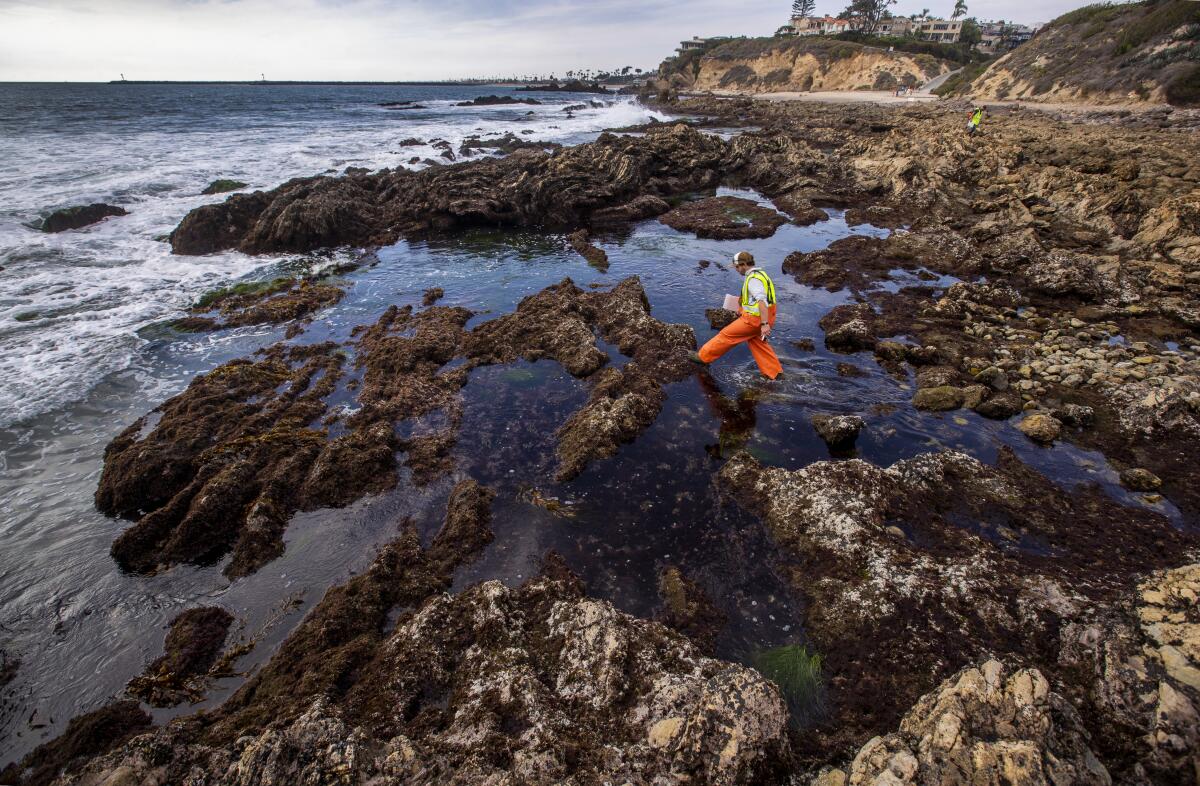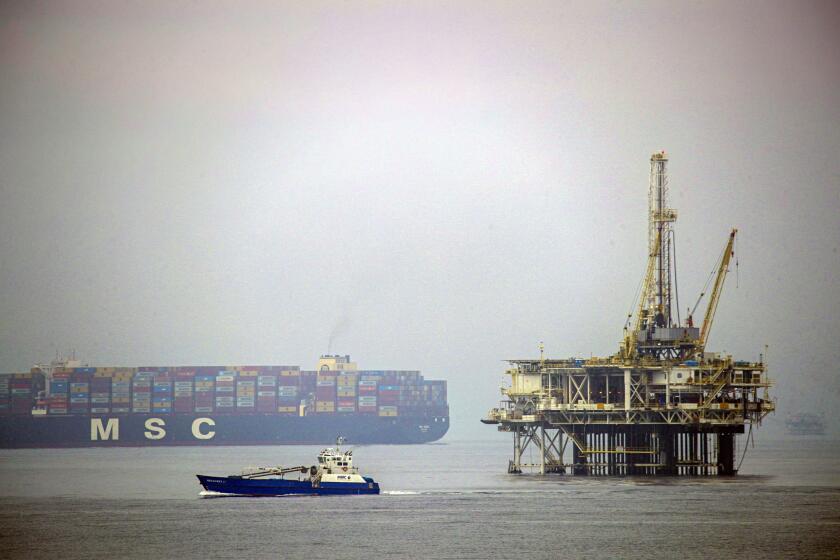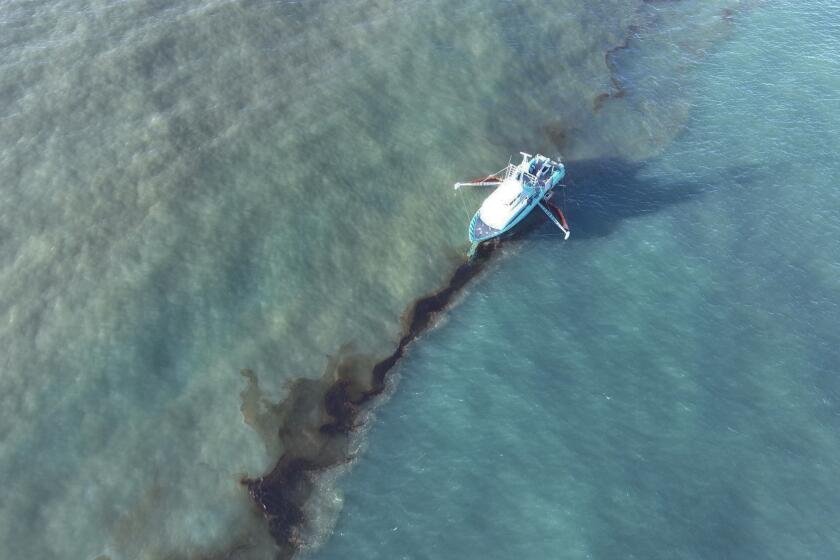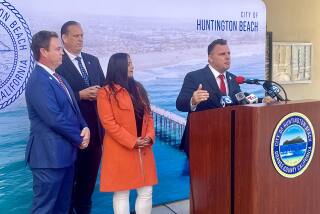Feds call for sweeping changes in Southern California shipping after 2021 oil spill

- Share via
A federal agency wants changes in how container ships are anchored off Southern California as well as new safety measures for vessels near offshore pipelines to help prevent or minimize ruptures like the one that spilled 25,000 gallons of crude oil off Huntington Beach.
The 2021 spill caused damage to beaches and wetlands and killed scores of fish and birds.
After a sweeping, two-year review, the National Transportation Safety Board released findings Tuesday that the Orange County spill was a direct result of container ships anchoring in close proximity to offshore pipelines. The board called for the U.S. Coast Guard to increase the buffer between anchored ships and pipelines.
The spill also could have been avoided with improved communication and planning between those monitoring the massive container ships in Southern California’s ports and the operators of the pipelines, investigators found.
The inquiry into the major oil spill off Huntington Beach confirmed initial findings that indicated a months-earlier anchor strike caused the undersea pipeline to burst, sending at least 25,000 gallons of oil into the Pacific. The investigation found no other possible cause of the damage, officials said at an almost four-hour NTSB meeting Tuesday.

NTSB investigators specifically blamed the “proximity of established anchorage positions to the pipeline,” which made it difficult for crews to prevent the anchors of two container ships from striking the pipeline during stormy weather in January 2021.
Though two ships — the MSC Danit and Cosco Beijing — struck the pipeline with their anchors, investigators determined the former caused the “initiating event” that led to the spill.
ExxonMobil officials withdrew plans to replace pipelines across Santa Barbara County, shuttered since the catastrophic 2015 Refugio oil spill. They may, however, want to restore old ones.
NTSB officials said that, given the ships’ locations, there was not sufficient time to weigh anchor or redirect the vessels when bad weather struck. This finding led the board to recommend that the U.S. Coast Guard revamp its plan governing the locations of ships anchored off Southern California to provide a greater margin of error among pipelines.
“Anchorages need to be designed to account for the size of vessels using them and the time it takes for these ships’ crews to react when anchor dragging occurs,” NTSB Chair Jennifer Homendy said in a statement.
In the 2021 incident off Huntington Beach, the initial contact from the anchor caused “progressive cracks” in Houston-based Amplify Energy’s 17.3-mile underwater pipeline, which eventually burst in October, almost nine months later. The two giant ships had been anchored outside the Long Beach and Los Angeles ports as vessels stacked up during the COVID-era supply chain backups, officials said.
The investigation found two other factors also contributed to the spill: When the ships dragged their anchors, the pipeline operators were never notified — a step that officials noted is not yet required. Also, months later, the operators’ response to leak alarms was significantly delayed.

Based on those findings, board members urged the Coast Guard to implement new alarms for its marine traffic monitors who stand watch over busy waterways, to signal when anchors might come close to pipelines in any U.S. waterway, as well as to put in place processes for notifying pipeline operators when such contact may have occurred.
Although the NTSB does not have regulatory or enforcement power, its recommendations carry weight.
Damage to the pipeline could have occurred weeks or months before the spill, two sources familiar with the investigation tell The Times.
Investigators also found that pipeline operators involved in the 2021 spill had “insufficient training,” which contributed to a 14-hour delay in halting the pipeline’s operation after the first alarm sounded to indicate a possible leak — confirming prior reports of a delayed response.
“It took eight total leak alarms before controllers shut down and isolated the line,” the NTSB said in a statement. “Had the San Pedro Bay Pipeline controllers responded in accordance with company procedures and shut down and isolated the line at the first alarm, it would have significantly reduced the volume of crude oil released and the resulting environmental damage.”
The NTSB board also is seeking a federal audit of the company operating the pipeline, a subsidiary of Amplify Energy. Although the report didn’t find any indication that drugs were a factor in the spill, it said operators were not given drug or alcohol tests after the spill — as regulations require — so it’s impossible to know for sure.
Amplify Energy did not directly address questions about the NTSB’s concerns related to pipeline operator’s training or drug testing, but a company spokesperson said its team is thankful for the NTSB’s “professionalism and service and will review their recommendations.”
“It’s now clear that two ships struck our pipeline and failed to report that hazardous condition,” Amy Conway, a spokesperson for Amplify Energy, said in a statement. “As the NTSB found in their investigation, had either international shipping company notified us of this anchor drag event, this event would not have occurred.”
Homendy, the NTSB chair, said the estimated damage and cleanup costs from the spill were $160 million, and a total of 116 dead birds were recovered.
“Although there were no human injuries, there most certainly was injury to the environment and to the wildlife and their habitats,” Homendy said Tuesday.
Up to 1.1 million gallons of oil may have been spilled into Gulf of Mexico from a pipeline off Louisiana’s southeast coast, U.S. Coast Guard says.
Pinpointing fault in the spill before these findings created a string of complicated lawsuits, court cases and settlements. It wasn’t immediately clear whether any would be affected by the federal investigation.
The companies behind the two container ships agreed earlier this year to pay Amplify Energy almost $100 million.
As for the energy firm, it pleaded guilty last year to federal environmental charges and later pleaded no contest to state charges, making financial payouts totaling millions of dollars in both cases. Amplify also agreed to pay $50 million to residents and business owners affected by the spill.
Earlier this year, the company reopened the pipeline after receiving an OK from federal regulators.
Times staff writers Laura J. Nelson and Hannah Fry contributed to this report.
More to Read
Sign up for Essential California
The most important California stories and recommendations in your inbox every morning.
You may occasionally receive promotional content from the Los Angeles Times.













